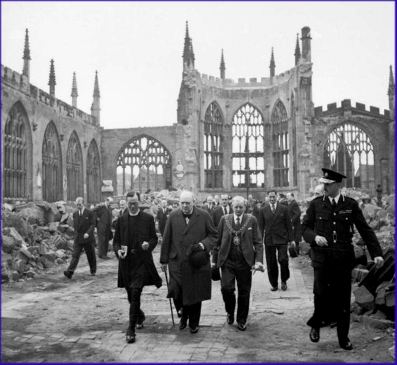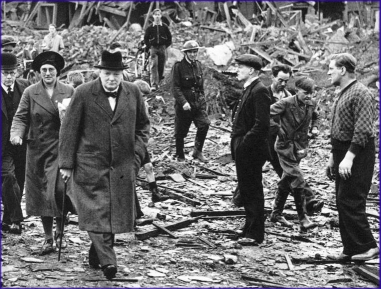
A visibly upset Churchill inspects the bombed-out remains of Coventry Cathedral, September 28, 1941.
While traveling across London one morning after another night of the blitz, Churchill happened to pass a storefront with a line of people waiting outside. Churchill was concerned about queues. He understood that, in time of war, queues mean shortages — shortages that can be the beginning of sagging morale, or even a sign of problems that lead to civil unrest. He had his driver stop, and his bodyguard ran back to ask what the queue was for.
“Birdseed,” he was told.
History doesn’t record what, if anything, Churchill did about the birdseed problem. Perhaps he took it as a sign that relief efforts were so far successful, and that morale was holding up for the moment. People had been bombed out of their homes, but they cared that the canaries of London be fed. That strikes me as a relatively good sign.
Whether canaries are fed may seem like a trivial matter for a prime minister struggling to not lose the greatest war in history, but small insights like this combine to give a better overall picture of the situation, that is to say, a better understanding of the system Churchill was building to destroy the German National Socialism that had engulfed Europe in war.
Churchill understood that an important part of gaining a better understanding of the system involved going and seeing for himself what was actually happening, whether that meant inquiring after birdseed, visiting an RAF base, handling and firing for himself the newly developed, crude and cheap but effective STEN submachine gun, visiting bombed-out sections of London or Manchester or Coventry, traveling to North Africa to confirm for himself reports of poor moral in the Eighth Army, or traveling across the world to meet Roosevelt and Stalin.

Churchill made it his business to go and see for himself how people were holding up as they inspected the rubble-strewn streets that had once been their homes.
Churchill was prime minister for slightly more than five years during the Second World War. In that time, he traveled at least 100,000 miles. German submarines in the Atlantic made travel by ship risky, but he traveled by ship when required. The transport aircraft available to Churchill traveled at under 200 mph, weren’t pressurized, and had ineffective heating (if they were heated at all), no small matter when flying to Russia in February, as Churchill did for the Yalta conference. This was a very strenuous travel schedule for an older man (he was 71 when the war ended).
Yet he went.
All his “going and seeing for himself” involved insuring that his directions, and the directions of his subordinates, had been clear. His “going and seeing for himself” involved asking questions and listening. Above all, his “going and seeing for himself” helped him to build for himself an accurate picture to the system that was intended to defeat the Axis powers.
In contrast, I have seen situations in which managers refused to walk 100 feet across a factory floor to see that a process that had once been deeply problematic was now world-class, and worthy of replication throughout the company. Refusing to go and see for themselves was hugely costly, and not just to the company; their compensation was in part based on the performance of that process.
Their failure to go and see for themselves was also deeply demoralizing to their subordinates who developed the processes, leading to higher turnover, with replacement staff much less skilled in the processes. Throwing money away like that is nutty, but not uncommon.
Leaders go and see for themselves.
More Leadership Lessons from Winston Churchill:
Listen.
Ask questions.
Give clear directions.
Don’t get angry at challenges to your ideas. Learn from them.
In most cases, it isn’t the person, it’s the process.
Learn to think in terms of a system.
Go and see for yourself.
Measure a lot of things, and have something to compare them to.
Have courage. Tell the truth, and expect others to do the same.
Great oratory is built on great arguments. Master your facts and your arguments first.
Copyright 2015, 2018 by Paul G. Spring. All rights reserved.
